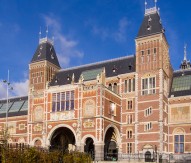

© EU-VRi
Building bridges with the nanoSTAIR
Research and innovation into nanotechnology will be once again replicated in Horizon 2020. With an estimated budget of €3.7bn under the Industrial Leadership pillar, this Key Enabling Technology is set to benefit significantly from the research and innovation framework programme.
The dissemination of knowledge is key to many industries to ensure the effective transfer of information across the sector, particularly the nanotechnology industry. Receiving funding under the Seventh Framework Programme, the nanoSTAIR project seeks to achieve this ease in the transfer of information. The project is co-ordinated by the European Virtual Institute for Integrated Risk Management and is supported by CEN-CENELEC, the European Committee for Standardisation (CEN) and the European Committee for Electrotechnical Standardization (CENELEC). The venture reflects significant cross-border co-operation, with seven EU member states involved in the project.
‘The overall objective of the nanoSTAIR project,’ the scheme’s website outlines, ‘is to build a sustainable process and platform in the field of nanotechnologies to support the transfer of knowledge gained through research to documentary standards in the context of the STAIR approach promoted by CEN-CENELEC.’
The project received nearly €500,000 of FP7 funding, contributing to the near full cost of the scheme and is scheduled for completion in March 2014.
‘The project is organised around several activities that will boost the development of new documentary standards. A mechanism will be setup to identify, with a bottom-up approach, the opportunities for standardisation from the results of research projects, co-funded by the European Commission or by national research programmes. This mechanism will be established using existing networks and initiatives such as NanoSafetyCluster or NANOfutures, as well as the network of the national standardisation bodies in the various member states.’
‘The expression of the needs for standards from various stakeholders will be collected and resources from consortia sharing similar standardisation opportunities will be pooled together to launch New Work Items Proposals (NWIP). The nanoSTAIR approach will be verified during the project thanks to two NWIPs initiated. The consortium will provide assistance to select the right standardisation umbrella,’ the webpage concludes.
Olivier Salvi is the work plan leader of the nanoSTAIR project and told Horizon2020projects.com more about the workings of the project.
“The STAIR Approach is a CEN-CENELEC Initiative which aims to transfer research outputs into standards. The nanoSTAIR approach aims to complete this in nanotechnology domains. The purpose of nanoSTAIR is then to develop a platform for enabling standardisation of research items into nanostandardisation technical committees.”
A key outcome of the project is the creation of the ‘nanoSTAIR platform’, which will gather together experts from across the field and encourage greater industry co-operation.
“The most important outcomes of the project are the nanoSTAIR platform which will bring together the best experts to launch standardisation work item proposals and the nanoSTAIR process to develop NWIP. The nanoSTAIR platform will be a place to find information, a place to find and meet potential partners and a place to find support.
“The nanoSTAIR platform is a virtual table where all stakeholders will have the opportunity to share common needs and solutions regarding new documentary standards. The nanoSTAIR platform will in particular bridge the research community and the standardisation community,” Salvi concluded.
Looking forward to Horizon 2020, Salvi said he hoped the method developed under nanoSTAIR would be extended to other research areas, though was sceptical on the ease of projects receiving funding from the European Commission.
“I hope the approach we develop in nanoSTAIR will be transferred to other research topics. I think Horizon 2020 is taking more care regarding the sustainability of research applications under the area of safe and clean technologies, which will receive a major contribution. The developments of new standards can also guarantee the absence of risks and the development of robust technics.
“Horizon 2020 introduces new simplicity in terms of rules of participation and I understand that the financial mechanics of the projects that will be largely facilitated more easily. However, regarding access to funding, many new partnerships are emerging from the initiative of the Commission or member states. These partnerships aim to prepare scientific and strategic roadmaps for guiding Horizon 2020 programmes; being prepared to Horizon 2020 will become more difficult.”
Olivier Salvi






